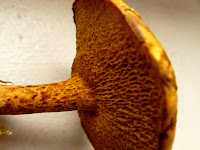After a couple of very dry weeks, we finally got enough precipitation in the DC region to allow mushrooms to grow. Nevertheless, because my wife is 9 months pregnant, I decided not to go out last weekend and, instead, decided to enjoy one of our last baby-free weekends together.
To my surprise (perhaps to compensate my predictable frustration), this weekend my in laws brought a box of nice looking mushrooms, all of the same species, and at various stages of development (as you know, one could not ask for anything better when trying to identify mushrooms). At a first they looked to me like either a Lepiota or
Chrolophylum molybdites. Given how frequent
C. molybdites is in our region and how easy it is to mistake it for one of the edible Lepiotas, I thought it was worth describing these in detail and to spend some time discussing their identification.
Location
Bowie, MD
 Habitat
Habitat
Gregarious, growing on mulch, in total 15 specimens collected at various developmental stages, some as cespitose (clusters of 2-3 specimens sharing the same stipe).
Measurements
Pileus diameter - 40-110 mm
Pileus height - 37-19 mm (not that I inverted the values since the smaller pilei are the ones which are the tallest and vice-versa)
Stipe height - 70-120 mm
Stipe diameter at apex - 10 mm
Stipe diameter at middle - 10-13 mm
Stipe diameter at base - 22-26 mm
 Description
Description
Pileus - Shape varying from convex to flat with umbo, round. Surface is scaly. Scales are concentric, pinkish-buff to brown color, with white between them. Flesh is white, bruising yellow-orange. Smell is non-distinctive.
Hymenium - Gills are free, close, smooth, white when young and red to brown when older.
Stipe - Central, clavate, hollow. With fringed ring located near the top (30/70). Above the ring the stipe is white and bellow it is brown-red. Ring is white on the upper surface and dark brown on the bottom. Right below the ring there is a dark brown circular belt. Flesh bruises yellow-orange.
Spore print - white
Impression
These are specimens of
Lepiota americana (Reddening Lepiota). They are considered choice edibles but can be confused with some poisonous look alikes and most guide books don't suggest these as being a good choice for beginners. For instance, one can easily mistake the Reddening Lepiota for the Green Spored Parasol (
Chlorophyllum molybdites). The major difference between the two being the spore color which is white for the Reddening Lepiota and green for
C. molybdites. Furthermore,
L. americana gills stain red as the mushroom ages while
C. molybdites gills tends to become green/gray with time.
C. molybdites is not supposed to be lethal but some say it can make you feel like dying. Other look alikes (which are not so worrisome) are the edible
Macrolepiota procera (Parasol Mushroom) and
Lepiota rachodes (Shaggy Parasol). The major differences between the Parasol Mushroom and the Reddening Parasol are that the former does not stain and that it has a slender stipe while the latter has a clavate (club shaped) stipe that stains yellow when cut. In regards to the Shaggy Parasol, the major difference is that its scales are much coarser (hence the "shaggy" on its name) and that it bruises brown instead of yellow/reddish. Although those focused on mushroom picking only for eating may not be to worried about mistaking one edible for another, giving the similarity between the four mushrooms described above I would highly recommend getting to know how to identify the four of them well.
Last, but not least. One could possibly mistake Lepiotas with Amanitas (a much more serious mistake with possible lethal consequences). Although Amanitas have volvas, one can easily miss the volva when collecting the mushroom if not careful enough and both genus have rings and white spores. For instance, one could mistake the Reddening Lepiota for the edible blusher (
A. rubescens) or, worse, with the poisonous
A. panterina or
A. flavorubescens.
References
Lincoff, G.H. National Audubon Society Field Guide to North American Mushrooms. Page 513.
Roody, W.C. Mushrooms of West Virginia and the Central Appalachians. Pages 66,68.
Kuo, M. 100 Edible Mushrooms. Pages 50-53;279-83.








































